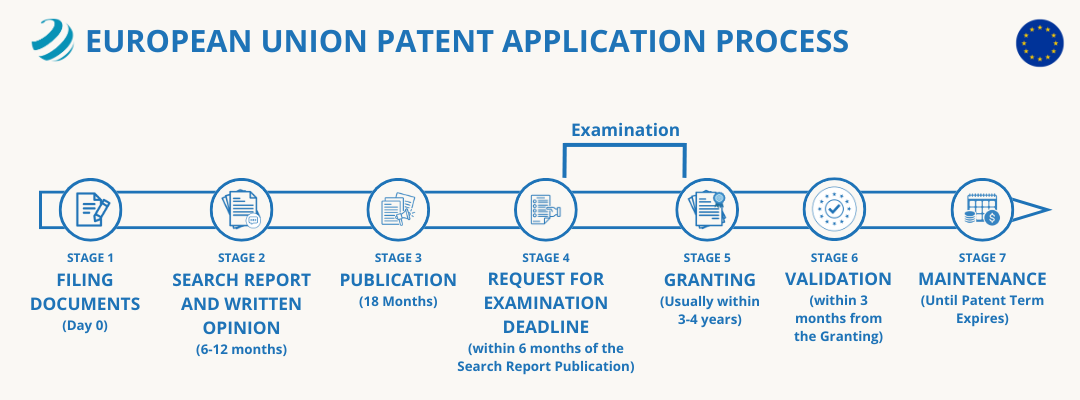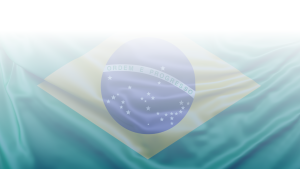Patent Filing in the European Union:
A Comprehensive Guide to the European Patent Filing Process
Filing a patent in the European Union involves a centralized process through the European Patent Office (EPO), enabling protection across multiple countries with a single application. Unlike filing separate national patents in each European country, the European Patent Convention (EPC) established a unified procedure for European Union patent filing and examination. Inventors and IP attorneys can apply for a patent in the European Union via the EPO, obtaining a European patent that can then be validated or registered in individual countries or take advantage of the new Unitary Patent system for broad coverage.
In this article, we provide a comprehensive guide to the European patent filing process, from application routes and examination to post-grant validation, with a focus on the EPO’s procedures and the latest Unitary Patent. We’ll also highlight how EU procedures differ from other jurisdictions and offer practical insights for patent prosecution in Europe.
Table of Contents
- Why It Is Important to File a Patent in the European Union
- European Patent Office vs National Patent Systems in Europe
- European Union Standard Patent Process Timeline
- Patent Filing Routes in the European Union: Direct Filing vs PCT National Phase
- Patent Filing Process in the European Union
- Post Granting Validation in the European Union
- Accelerated Examination Options in the European Union

Why It Is Important to File a Patent in the European Union
Filing a patent in the European Union provides access to one of the world’s most innovative and commercially significant regions through a single EPO examination. In 2024, the European Patent Office received nearly 199,000 patent applications, confirming Europe’s status as a global leader in research and technology, with strong growth in areas such as electrical machinery and energy (+8.9%). A European patent, can secure protection across multiple EU countries, helping block competitors, attract investors, and strengthen licensing potential.
Because EPO examination standards are among the strictest worldwide, granted patents are recognized as high-quality and defensible assets. Strategically, European Union patent filing enables innovators to align product launches with a large, integrated market while minimizing administrative costs through a single, centralized process, especially when opting for unitary protection.
European Patent Office vs National Patent Systems in Europe
The European Patent Office (EPO) is the central authority for examining and granting patents that can take effect in up to 39 countries across Europe. All EU member states and several non-EU countries (such as the UK, Switzerland, Norway, and others) are contracting states of the EPC, which means an EPO application can potentially cover them all. By contrast, filing directly with national patent offices (e.g., the French INPI or German DPMA) yields protection only in that single country. The EPO route greatly simplifies European Union patent filing by avoiding multiple parallel national applications, ensuring a unified examination process and high-quality search for prior art (EPO).
However, it’s important to note that a European patent granted by the EPO does not automatically become a single “EU patent” with unitary effect. Instead, after grant the European patent essentially becomes a bundle of national patents in the designated countries, and it must be validated (formalized) in each country where protection is sought (EPO). Each validated national patent is subject to that country’s laws, which means the role of national patent offices comes into play post-grant: they handle publication of translations, collect renewal fees, and record the patent in the national register.
Key Insight
European Union Standard Patent Process Timeline
The European patent process follows a structured sequence designed to ensure thorough examination and high-quality patent grants. From the initial filing to the final grant, applicants must complete several procedural steps, each with its own deadlines and strategic considerations. The overall process typically takes between 3 to 5 years, depending on the complexity of the invention and the responsiveness of the applicant.
Below is an overview of the standard patent process timeline in Europe, as managed by the European Patent Office (EPO).

Patent Filing Routes in the European Union: Direct Filing vs PCT National Phase
The two primary application pathways for a European patent application are, a direct European patent application filed with the EPO, or an international PCT application followed by entry into the European regional phase. In either case, the end result can be an EPO examination and potentially a granted European patent. Here’s an overview of these routes.
1. Direct National Filing or Paris Route
You can apply directly to the EPO for a European patent, either as a first filing or within 12 months of a priority application (EPO). The application is filed under the EPC, designating some or all member states. The EPO then conducts the search and examination.
This route is typically chosen if Europe is a primary or early target for protection. The European patent application can be filed electronically with the EPO and must be in one of the EPO’s official languages or translated into one (EPO). A direct EPO filing will be processed immediately by the EPO. A search report with a preliminary opinion on patentability is usually issued first, followed by substantive examination.
2. PCT National Phase Entry
If you are pursuing a global patent strategy, you might start with an international application under the Patent Cooperation Treaty (PCT). To apply for a patent in the European Union through this route, you must enter the European regional phase at the EPO within 31 months from the earliest priority date of the PCT application (EPO). By that time, you must file the necessary documents with the EPO, pay the filing fee, provide a translation of the application if it was not published in English, French, or German, and pay the search (if required) and examination fees (EPO).
When the EPO acted as the International Searching Authority (ISA) or as the International Preliminary Examining Authority (IPEA) during the PCT stage, applicants benefit from significant fee reductions at regional phase entry. In such cases, no supplementary European search fee is required because the EPO already conducted the search in the international phase. This avoids duplication of work and reduces overall official costs for European entry. Conversely, if another patent office (e.g., USPTO, JPO, CNIPA) served as the ISA, the EPO will perform a supplementary European search, for which an additional search fee must be paid upon entry.
The Euro-PCT route effectively allows applicants to defer the decision and costs of entering the European system while maintaining their priority rights. This can be strategically useful for assessing the invention’s commercial viability, refining the claims based on international search results, or coordinating filing and prosecution across multiple jurisdictions before committing to the European regional phase.

No matter which route is chosen, once the application is under EPO jurisdiction, it is treated according to the EPC rules. This means a European search report will be issued (unless already done during the PCT by the EPO), publication of the application will occur at 18 months from the priority date, and the patent prosecution in Europe (examination, communications, etc.) will follow the standard EPO procedure.
Key Insight
Patent Filing Process in the European Union
Once your application is filed via one of the routes above, it enters the EPO patent grant process. The procedure at the EPO is rigorous and multi-staged, aimed at ensuring only patentable inventions (novel, inventive, industrially applicable) are granted. Below is a step-by-step overview of what happens from filing to grant of a European patent.

Required Documents
Upon filing the application, whether direct or via PCT regional phase, the EPO assigns an application number and filing date. The application must contain at least a description and claims, and drawings if applicable.
The EPO performs a formalities examination at this stage to ensure all administrative requirements are met. If something is missing (e.g., certain declarations or an abstract), the EPO will invite the applicant to correct it. At this stage, the filing fee and (for direct filings) the search fee, need to be paid within one month of filing. Notably, if the application as filed had more than 15 claims, excess claim fees will be due, and these must be paid within the set time.

Search and Publication
The EPO’s search division, an examiner or examiners specialized in the field, will conduct a prior art search to find relevant existing literature (patents, articles, etc.) related to the invention. The goal is to assess novelty and inventive step. The result is issued as a European Search Report (ESR), usually accompanied by a search opinion on patentability. The search report is typically completed within about 3–6 months for standard cases, though it can take longer if the application is complex or requires the applicant’s response to unity of invention issues.
The application is published, in the EPO’s official languages, 18 months after the priority date, or after the filing date if no priority. At publication, third parties can submit observations, but cannot yet oppose as opposition comes after grant.

Examination
To initiate examination, the applicant must have filed a Request for Examination and paid the exam fee. For direct applications, this can be done up to 6 months after the European Patent Bulletin mentions publication of the search report, or you may file the request early, even at filing time, to speed things up. In PCT regional phase cases, the exam fee is due upon regional entry, or within 6 months of EPC publication of the search report if a supplementary search was done. At Patenterea we suggest requesting examination at the Filing Stage to simplify and speed up the process.
Once examination begins, the file is assigned to an examining division. The examiner reviews the application in detail against the patentability criteria (novelty, inventive step, clarity, support, etc.) and then will issue examination reports (office actions) if objections are found. The applicant has an opportunity to respond, amend the claims, argue, and overcome the objections. This back-and-forth may involve several rounds. The timeline here can vary widely: it may take 1–2 years from the request for examination to receive a first examination report, and total prosecution time often ranges from 2 to 4+ years depending on complexity and applicant’s responses, and whether accelerated examination is requested via programs like PACE or PPH.

Granting
Once the examining division intends to grant the patent, the EPO issues a communication, inviting the applicant to complete formal steps within four months. During this period, the applicant must: 1. Pay the grant (printing) fee and the publication fee for the specification, 2. File translations of the claims into the EPO’s other two official languages and 3. Confirm approval of the text intended for grant.
Once these requirements are met, the EPO issues the decision to grant, and the patent is published in the European Patent Bulletin. The publication date marks the official grant date of the European patent and triggers two important post-grant periods:
-
A nine-month opposition period, during which third parties can file an opposition to challenge the patent’s validity centrally before the EPO.
-
A three-month validation period follows, during which the patent owner must validate the granted European patent (classic) in each designated country and decide whether to request a Unitary Patent.
Validation involves completing any national requirements, such as filing translations, paying national publication fees, and designating a local representative if necessary. Missing this three-month window causes the patent to lapse in the countries where validation was not completed.

Maintenance
After granting annual fees must be paid to keep the application alive, starting from the 3rd year from filing counted from the filing date. If a renewal fee is not paid by its due date, the application will lapse (after a grace period). This is different from some jurisdictions like the US, where maintenance fees are due only after grant. In Europe, you pay to maintain an application in the pipeline. After grant, renewal fees in each country (or centrally for a unitary patent) will be due to keep the patent in force up to the 20-year term.
Key Insight
The EPO patent process spans several years, from filing, search, and examination to grant, requiring active management of fees, deadlines, and formalities. Applicants must request examination, comply with granting requirements, and plan for costs and timelines of about 3–4 years, ensuring the process aligns with their global IP strategy.
Post Granting Validation in the European Union
Once the European Patent Office (EPO) grants a European patent, it does not automatically take effect in all EU countries. To make the patent enforceable, the patent holder must complete post-grant validation in each country where protection is desired, unless the Unitary Patent option is chosen. Please find below an overview of the patent validation options.
1. European Patent (Classic)
This is the conventional outcome of the EPO grant procedure under the European Patent Convention. A European patent, once granted, can be validated in any or all of the 39 EPC Member States that were designated at filing. Validation must typically be completed within three months from the EPO grant publication date. Missing a country’s validation deadline causes the patent to lapse there from the outset.
To validate your patent in any of the EPC Member States, you should file translations of the claims or the full specification (depending on the country’s language rules), pay national fees for publication or registration (when applicable), and provide an address for service or appointing a local representative in certain jurisdictions. If you are interested in extension/validation states an independent designation fee is required at the filing stage. These are Bosnia and Herzegovina (BA), Morocco (MA), Republic of Moldova (MD), Tunisia (TN), Cambodia (KH), and Georgia (GE).
After validation, your patent essentially becomes a bundle of independent national patents in those countries.
Each country must be maintained through annual renewal fees and enforced separately through national courts, unless litigation is taken to the new Unified Patent Court (UPC) for those EU states that participate in it and haven’t been opted out.
2. Unitary Patent
The Unitary Patent system offers a single patent right covering multiple EU countries via one post-grant request (EPO). Under the Unitary Patent system, validation is replaced by a single request for unitary effect filed with the EPO within one month of grant. This eliminates individual national formalities and provides uniform protection across 18 participating EU member states through one registration and a single renewal fee.
A Unitary Patent is obtained by filing a request for unitary effect at the EPO within one month of the European patent’s grant publication. Once the EPO registers the unitary effect, the patent becomes a European Patent with unitary effect, providing uniform protection and equal effect in all participating member states of the EU that have joined the system (EPO).
Initially, the Unitary Patent covers 18 EU countries (as of October 2025): Austria, Belgium, Bulgaria, Denmark, Estonia, Finland, France, Germany, Italy, Latvia, Lithuania, Luxembourg, Malta, the Netherlands, Portugal, Romania, Slovenia, and Sweden. The Unitary Patent is a single indivisible right across those states. It does not require individual national validations in those countries and is enforceable centrally before the Unified Patent Court. It also has a single renewal fee and is administered centrally by the EPO after grant, reducing maintenance costs and administrative burden.
From a strategic perspective, a classic European patent (without unitary effect) gives you freedom to drop or maintain protection country-by-country, since each validation is independent, and avoid the risk of a single central revocation affecting all jurisdictions. On the other hand, a Unitary Patent offers a one-stop administration, with one renewal to pay, one patent to enforce or license, and can be cost-effective if protection is needed in many EU countries. The unitary route can significantly reduce translation costs and validation fees. Enforcement for unitary patents is centralized in the Unified Patent Court, which can be an advantage, as one lawsuit covers all countries, but also a risk, as one revocation action could invalidate the patent in all 18 states at once.
Key Insight
Accelerated Examination Options in the European Union
Filing a patent in Europe involves strategic choices that can significantly affect protection scope, costs, and long-term enforceability. By carefully planning the route, timing, and coverage, applicants can optimize both their patent rights and their global IP strategy. Below are key recommendations for inventors and IP attorneys when pursuing European Union patent filing.
1. Acceleration Options: Programme for Accelerated Prosecution of European Patent Applications (PACE)
This is a free, opt-in program open to any patent applicant at the EPO. By filing a simple request, separately for the search phase and the examination phase, you ask the EPO to fast-track your application. If accepted, the EPO will then prioritize your case and aim to issue the next search or examination report much sooner than usual, often within about 3 months for examination. This can shave years off the process, helping you secure a granted patent faster when timing is critical. Please consider that you can only request PACE once per stage, and you must keep up with the accelerated pace. If you request an extension or cause delays, the application is removed from PACE and cannot re-enter the program. Moreover, the EPO expects applicants to use PACE sparingly for their most important cases. PACE requests are not publicly disclosed in the patent file, so third parties won’t know you’ve requested acceleration.
2. Patent Prosecution Highway (PPH)
The PPH is an agreement-based program that lets you accelerate examination at the EPO by leveraging a positive outcome from another patent office. The EPO has PPH arrangements with about 15 other offices (including the US, Japan, China, and more). If you have a corresponding application in one of those jurisdictions and at least one claim has been deemed patentable there, you can request fast-track examination of the European application under PPH. To use this, the European application must share the same priority/filing as the foreign application, and you should file the PPH request before the EPO begins substantive examination. The EPO will then process your case on a timeline comparable to PACE. One advantage is that EPO examiners can re-use work done by the other office, such as prior art searches or claim amendments, potentially streamlining the review. Please consider that even with PPH, the EPO will apply its own patentability criteria. There’s no automatic acceptance of the foreign office’s findings. European examiners may still raise EU-specific objections, so an allowed U.S. claim, for example, isn’t guaranteed to be allowable in Europe. Also, unlike PACE, a PPH request is noted in the application’s public file, meaning competitors or other third parties can see that you have requested accelerated examination via PPH. Nonetheless, PPH is a useful strategy when you already have an allowed patent elsewhere and want to speed up the European patent grant based on that head start.
Key Insight
Strengthen Your Global IP Strategy with a European Patent
Filing patents in Europe is a strategic cornerstone for global IP protection. A single European patent or Unitary Patent can secure broad coverage across key EU markets through one examination, offering high-quality, credible protection recognized worldwide.
The Unitary Patent system simplifies costs and renewals, while the Unified Patent Court allows centralized enforcement across multiple countries. European patents also provide flexibility for tailored licensing and complement global filings through mechanisms like the PCT and PPH. Overall, protecting innovation via the EPO strengthens international competitiveness, optimizes portfolio management, and enhances a company’s global IP strategy.

Get your Patent Filed in the European Union
Contact us today for a free consultation
References
- European Patent Office (EPO). Member states of the European Patent Organisation. Available here. (Reviewed on October 2025)
- European Patent Office (EPO). Unitary Patent & Unified Patent Court. Available here. (Reviewed on October 2025)
- European Patent Office (EPO). European Route. Available here. (Reviewed on October 2025)
- European Patent Office (EPO). National Route. Available here. (Reviewed on October 2025)
- European Patent Office (EPO). International Route. Available here. (Reviewed on October 2025)
- European Patent Office (EPO). Languages for European patent applications. Available here. (Reviewed on October 2025)
- European Patent Office (EPO). Agreement on the application of Article 65 EPC – London Agreement. Available here. (Reviewed on October 2025)



